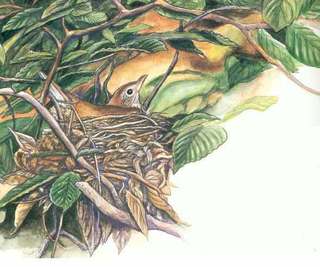Flute's Journey: The Life of a Wood Thrush

HOW KIDS HELPED TO SAVE BELT WOODS
This is a true story. When Lynne Cherry was just beginning to write Flute's Journey, a friend of hers who studied birds, asked her to put Flute in The Belt Woods. She explained to Lynne that Belt Woods was a 600 acre tract of land that had more nesting migratory birds than anywhere else in the Washington DC area but, she told Lynne, the Belt Woods was in danger of being cut down for a housing development.
The Belt Woods was owned by a man named Seton Belt. It had been in his family since it was given to them as a land grant from the King of England hundreds of years before. Seton Belt's family, for many generations, did not cut down the trees and so, when Seton Belt was an old man, he wanted to will his land to a group that would continue to protect it. He willed it to the Episcopal Church and in the will it said that no trees would be cut and the land would not be sold.
However, after Seton Belt died, the Episcopal church had the will overturned and was planning to sell it to a developer for $9 million. Many members of the church who had known Seton Belt tried to convince the church not to sell the land to a developer. The Trust for Public Land offered to buy the land for $4.5 million but, initially, the church turned down that offer.
As Lynne was speaking to groups of schoolchildren around the US, she told this story to them and she asked them to write to the bishop of the episcopal church, Reverend Haines.
Some of the letters were very hard-hitting. Here are a few of them:
"Dear Reverend Haines,
You got the land for free. Can't you take the $4.5 million that the Trust for Public Land has offered you and save the land?"
"Dear Reverend Haines,
Seton Belt trusted you. How can you go against him?"
"Dear Reverend Haines,
God is going to be really mad at you!"
These letters were powerful. The children who wrote them were interviewed and they read their letters on Sunday morning News With Charles Osgood which brought national attention to Belt Woods. The week afterward, the church announced that they would sell the land to the Trust for Public Land and it would be protected forever.
Kids letters can really make a difference. Kids can help save open space if they understand how important it is to save these vanishing ecosystems.
Flute's Journey LINKS
Living on Earth click to listen to Lynne Cherry read (on the mp3 logo) Flute's Journey on NPR
Activities to Do After Reading Flute's Journey
After reading Flute’s Journey,read the Birds and Save the Land You Love issues of Nature’s Course at SchoolsGoGreen.org.
*Take a nature walk or hike with your local Sierra Club or Bird Club. Most communities have a chapter of Sierra Club or another outdoor club. Discover the natural world in your community with your family and friends by going on some of the hikes offered by these outdoor clubs. You can find contact information for these local clubs on the internet by putting in “Bird Club + the name of your town or “Sierra club” + the name of your town.
*Learn About Saving Open Space in Your Community. On the internet find out what conservation activities are happening in your community.
*Naturalize and restore your back yard and your schoolyard.
*Plant Cedar trees which provide food for many migrating birds, especially cedar waxwings. You can find information about which plants to plant by going to the Resources section in the Butterflies and the Birds issues of Nature’s Course at the website of the Center for Children’s Environmental Education (CEE) at SchoolsGoGreen.org.
*Try to locate bird habitat in your community. Work to preserve it and.begin to create bird habitat in your yard and in community.
*Remind your family and neighbors about the importance of keeping their cats indoors while birds are nesting and fledging in the spring.
*Research what conservation activities are happening in your community. Check the local newspapers. Find a local land trust by keying in “Land Trust + the name of your town or the nearest city. You might be able to find out about a woods or piece of land they are trying to preserve and help to preserve it.
*Begin the process of naturalizing/restoring your back yard and schoolyard. Grass provides habitat for very few other living things. Dig up some of the lawn around the school and plant berry-bearing bushes for the birds and butterfly bushes.
*After reading Flute’s Journey,read the Birds and Save the Land You Love issues of Nature’s Course at SchoolsGoGreen.org.
*Take a nature walk or hike with your local Sierra Club or Bird Club. Most communities have a chapter of Sierra Club or another outdoor club. Discover the natural world in your community with your family and friends by going on some of the hikes offered by these outdoor clubs. You can find contact information for these local clubs on the internet by putting in “Bird Club + the name of your town or “Sierra club” + the name of your town.
*Learn About Saving Open Space in Your Community. On the internet find out what conservation activities are happening in your community.
*Naturalize and restore your back yard and your schoolyard.